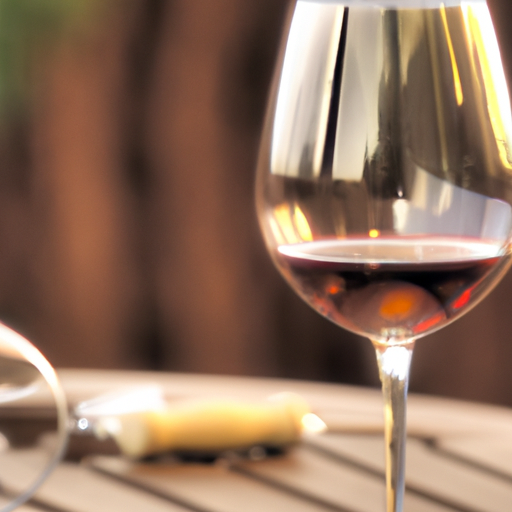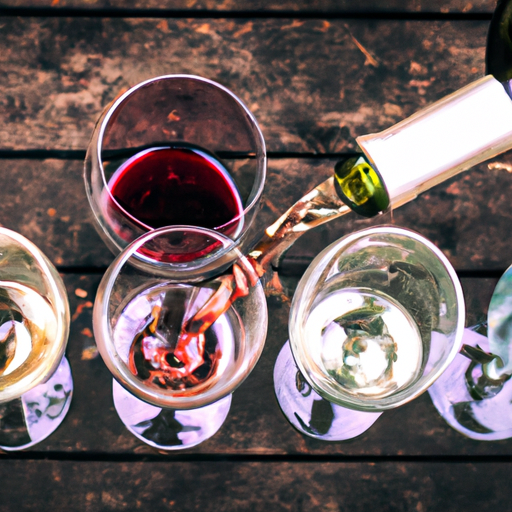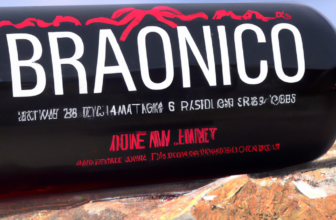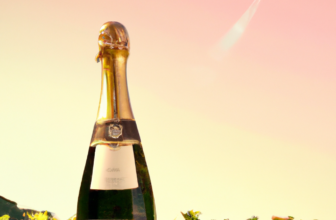
The Art of Wine Photography: Showcasing the Beauty of Viniculture
Captivating Wine Photography: A Celebration of Viniculture
Wine has long been celebrated for its rich flavors, complex aromas, and ability to enhance any occasion. But beyond the taste and experience of drinking wine, there is another aspect that captivates wine enthusiasts and photographers alike – the art of wine photography. Through the lens of a camera, wine photography showcases the beauty of viniculture, capturing the essence of the winemaking process and the allure of the vineyards.
Wine photography is more than just taking pictures of bottles and glasses. It is an art form that requires skill, creativity, and an understanding of the subject matter. The goal is to create images that evoke emotions, tell a story, and transport the viewer to the world of wine.
One of the key elements of wine photography is capturing the vineyards themselves. These sprawling landscapes, with their neatly arranged rows of vines, are a sight to behold. The photographer must find the perfect angle, the right lighting, and the ideal composition to showcase the beauty of the vineyards. Whether it’s a close-up shot of the vines or a panoramic view of the entire vineyard, the goal is to convey the sense of tranquility and serenity that comes with being in the presence of nature’s bounty.
Another important aspect of wine photography is capturing the winemaking process. From the harvesting of the grapes to the fermentation and aging in oak barrels, each step in the winemaking process is a work of art in itself. The photographer must capture the essence of these processes, highlighting the colors, textures, and movements that make winemaking so fascinating. Whether it’s the vibrant hues of the grapes or the swirling motion of the wine being poured, these images bring the viewer closer to the magic that happens behind the scenes.
Of course, wine photography wouldn’t be complete without showcasing the final product – the wine itself. Bottles, glasses, and wine accessories become the subjects of the photographer’s lens. The challenge here is to capture the elegance and sophistication that wine represents. The play of light on the glass, the rich colors of the wine, and the intricate details of the labels all contribute to creating a visually stunning image. These photographs not only showcase the beauty of the wine but also serve as a reminder of the pleasure and enjoyment that comes with savoring a glass of fine wine.
In recent years, wine photography has gained popularity as a form of art and a means of storytelling. Wine enthusiasts and photographers have come together to create stunning images that not only capture the beauty of viniculture but also tell the stories of the people behind the wine. From the winemakers and vineyard owners to the sommeliers and wine lovers, each photograph becomes a testament to their passion and dedication.
In conclusion, wine photography is a celebration of viniculture. It is an art form that showcases the beauty of the vineyards, the intricacies of the winemaking process, and the elegance of the final product. Through the lens of a camera, wine photography transports us to the world of wine, evoking emotions and telling stories. So next time you raise a glass of wine, take a moment to appreciate the artistry that goes into capturing its essence through captivating wine photography.
Capturing the Essence: Exploring the Aesthetics of Wine Photography

Captivating Wine Photography: A Celebration of Viniculture
Capturing the Essence: Exploring the Aesthetics of Wine Photography
Wine, with its rich history and cultural significance, has long been a subject of fascination for photographers. From the vineyards to the cellars, wine photography offers a unique opportunity to capture the essence of viniculture. In this article, we will delve into the aesthetics of wine photography and explore how photographers can create captivating images that celebrate the beauty and allure of wine.
One of the key elements of wine photography is capturing the unique colors and textures of wine. From the deep reds of a robust Cabernet Sauvignon to the pale gold of a crisp Chardonnay, wine offers a wide range of hues that can be visually striking. Photographers can experiment with lighting and composition to highlight these colors and create images that are both visually appealing and evocative of the wine’s character.
In addition to color, texture plays a crucial role in wine photography. The glistening droplets on a wine glass or the velvety smoothness of a wine bottle can add depth and interest to an image. By paying attention to these details and using macro photography techniques, photographers can capture the tactile qualities of wine and create images that invite viewers to imagine the sensory experience of tasting it.
Another important aspect of wine photography is capturing the sense of place. Vineyards, with their rolling hills and neatly arranged rows of vines, provide a picturesque backdrop for wine photography. By incorporating elements of the vineyard landscape into their images, photographers can convey a sense of the terroir, or the unique environmental factors that influence the flavor of the wine. Whether it’s the sun-drenched hills of Tuscany or the misty valleys of Napa Valley, the location of a vineyard can add a layer of storytelling to wine photography.
Composition is also crucial in wine photography. By carefully arranging the elements within the frame, photographers can create visually pleasing images that draw the viewer’s eye to the subject. The rule of thirds, leading lines, and symmetry are all techniques that can be employed to create balance and harmony in a wine photograph. Additionally, photographers can experiment with different angles and perspectives to add interest and create a sense of depth in their images.
Furthermore, props and styling can enhance the aesthetics of wine photography. From elegant wine glasses to rustic wooden barrels, the choice of props can help set the mood and create a narrative within the image. By carefully selecting and arranging these elements, photographers can create images that tell a story and evoke emotions in the viewer.
Lastly, post-processing plays a crucial role in enhancing the aesthetics of wine photography. By adjusting the colors, contrast, and sharpness, photographers can fine-tune their images to achieve the desired look and feel. However, it is important to strike a balance and avoid over-processing, as it can detract from the natural beauty of the wine.
In conclusion, wine photography offers a unique opportunity to capture the essence of viniculture. By paying attention to color, texture, sense of place, composition, props, and post-processing, photographers can create captivating images that celebrate the beauty and allure of wine. Whether it’s a close-up of a wine glass or a sweeping landscape of a vineyard, wine photography allows us to appreciate the artistry and craftsmanship that goes into every bottle of wine. So, grab your camera and raise a glass to the captivating world of wine photography!
Wine and Photography: A Perfect Blend of Art and Culture
Wine and photography have long been intertwined, forming a perfect blend of art and culture. Captivating wine photography captures the essence of viniculture, showcasing the beauty and allure of this ancient beverage. From vineyards to wine cellars, from wine bottles to wine glasses, photographers have found endless inspiration in the world of wine.
One of the reasons wine and photography go hand in hand is their shared ability to evoke emotions. Just as a sip of wine can transport us to a different time and place, a well-crafted photograph can elicit a range of feelings. Whether it’s the warm hues of a sunset over a vineyard or the delicate bubbles in a glass of champagne, wine photography has the power to captivate and engage viewers.
In addition to evoking emotions, wine photography also serves as a visual celebration of viniculture. Vineyards, with their neatly arranged rows of grapevines, provide a stunning backdrop for photographers. The rolling hills, the lush greenery, and the symmetrical patterns of the vines all contribute to the visual appeal of these landscapes. Photographers often use different angles and perspectives to highlight the unique characteristics of each vineyard, showcasing the diversity and beauty of the wine-growing regions.
But wine photography is not limited to vineyards alone. Wine cellars, with their dimly lit interiors and rows of aging barrels, offer a different kind of visual allure. The play of light and shadow, the rich colors of the wooden barrels, and the sense of history and tradition all make wine cellars a fascinating subject for photographers. These images not only showcase the craftsmanship and dedication that goes into winemaking but also transport viewers into a world of mystery and elegance.
Of course, wine photography wouldn’t be complete without capturing the wine itself. Photographers often focus on the bottles, using creative lighting and composition to highlight their unique shapes and labels. The vibrant colors of red wines, the pale hues of white wines, and the effervescence of sparkling wines all come to life through the lens of a skilled photographer. These images not only showcase the visual appeal of wine but also serve as a testament to the craftsmanship and artistry of winemakers.
In recent years, social media platforms like Instagram have played a significant role in popularizing wine photography. Wine enthusiasts and photographers alike have taken to these platforms to share their passion for wine through visually stunning images. From close-up shots of wine glasses to aerial views of vineyards, these photographs have become a source of inspiration and admiration for wine lovers around the world.
In conclusion, wine and photography form a perfect blend of art and culture. Captivating wine photography captures the essence of viniculture, evoking emotions and celebrating the beauty of this ancient beverage. From vineyards to wine cellars, from wine bottles to wine glasses, photographers have found endless inspiration in the world of wine. Through their lens, they transport us to the heart of viniculture, inviting us to savor the beauty and allure of this timeless art form. So next time you raise a glass of wine, take a moment to appreciate the artistry that goes into capturing its essence through the lens of a camera.






